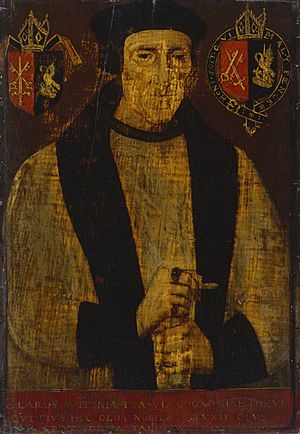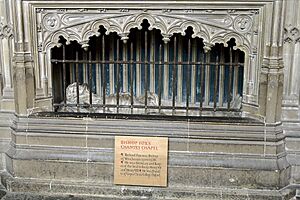Richard Foxe facts for kids
Quick facts for kids Richard Foxe |
|
|---|---|
| Bishop of Winchester | |
 |
|
| Church | Roman Catholic |
| Appointed | 20 August 1501 |
| Reign ended | 5 October 1528 |
| Predecessor | Thomas Langton |
| Successor | Thomas Wolsey |
| Orders | |
| Consecration | 8 April 1487 by John Morton |
| Personal details | |
| Born | c. 1448 Ropsley, Lincolnshire, England |
| Died | 5 October 1528 (aged 79–80) England |
| Denomination | Roman Catholic |
| Previous post | Bishop of Exeter Bishop of Bath and Wells Bishop of Durham |
| Coat of arms |  |
Richard Foxe (born around 1448 – died October 5, 1528) was an important English church leader. He is famous for starting Corpus Christi College, Oxford, a well-known university college. During his life, he served as a bishop in several important places: Exeter, Bath and Wells, Durham, and Winchester. He also held a powerful government job as the Lord Privy Seal, which meant he kept the king's special seal for important documents.
Contents
Richard Foxe's Early Life and Education
Richard Foxe was born in a village called Ropsley in Lincolnshire, England. His family were farmers, and not much is known about his early years. He likely studied at Magdalen College, Oxford, and possibly at Cambridge University. From 1477, he was the head teacher at a school in Stratford-upon-Avon. People described him as a "man of wisdom, knowledge, learning and truth."
How Foxe Met King Henry VII
In 1484, Foxe was in Paris. Some believe he was there to study, while others think he might have been avoiding King Richard III. In Paris, he met Henry Tudor, who was planning to become the next king of England. Foxe joined Henry's team. King Richard III even tried to stop Foxe from getting a church job because he was friends with Henry Tudor.
Richard Foxe's Role in Government
After Henry Tudor won the Battle of Bosworth and became King Henry VII, Richard Foxe quickly gained important positions. The new king trusted Foxe a lot. Henry VII preferred to have smart lawyers and churchmen like Foxe in his government, rather than relying on powerful nobles.
Working as a Royal Secretary
Foxe became the king's main secretary and soon after, the Lord Privy Seal. He was also made Bishop of Exeter in 1487. Being a bishop gave him a good income, which helped him serve the king without costing the royal treasury too much. Foxe spent most of his time on political and diplomatic work, helping the king with foreign relations.
Important Diplomatic Missions
Foxe played a key role in many important agreements:
- In 1487, he helped make a peace treaty with King James III of Scotland.
- In 1491, he was present at the baptism of the future King Henry VIII of England.
- In 1492, he helped finish the Peace of Etaples, a treaty with France.
- In 1493, he was the main negotiator for a big trade agreement with the Netherlands, known as the Magnus Intercursus.
Bishop of Durham and Winchester
In 1494, Foxe became the Bishop of Durham. This was an important role because Durham was a powerful area near the border with Scotland. Foxe lived in his new diocese and even helped defend Norham Castle against a Scottish attack in 1497.
Peace with Scotland
Foxe worked hard to improve relations with Scotland. In 1497, he helped arrange for Perkin Warbeck, a pretender to the English throne, to leave the Scottish court. Then, in 1498–1499, he helped set up the marriage between the Scottish King James IV and Henry VII's daughter, Margaret. This marriage was very important because it eventually led to England and Scotland being united under one king in 1603.
Bishop of Winchester and Royal Marriages
In 1501, Foxe became the Bishop of Winchester, which was one of the richest church positions in England. That same year, he helped arrange the marriage between Prince Arthur (Henry VII's son) and Catherine of Aragon. He also helped arrange the engagement of the king's younger daughter, Mary, to the future emperor Charles V.
Foxe's Later Years and Legacy
When Henry VIII became king, Foxe's influence grew even more at first. He was considered one of the most trusted advisors. However, a new powerful figure, Thomas Wolsey, soon rose to power.
Wolsey's Rise and Foxe's Retreat
By 1511, Wolsey's quick rise meant that Foxe's influence began to fade. Foxe disagreed with Wolsey's aggressive foreign policy, especially against France. He eventually resigned from his role as Lord Privy Seal in 1516. After this, Foxe focused more on his duties as a bishop.
Efforts for Church Reform
Foxe was keen to improve the clergy (church leaders) and monasteries, which he felt had become corrupt. However, he was getting old and his eyesight began to fail in his last ten years. He died on October 5, 1528.
Founding Corpus Christi College
The most lasting achievement of Richard Foxe's career was founding Corpus Christi College, Oxford in 1515–1516. He originally planned it as a place for monks, but he was advised to make it a college for students instead. The college was designed to teach Greek, Latin, and early Christian writings. Famous thinkers like Erasmus praised the new college. Foxe also built and supported grammar schools in Taunton and Grantham.
See also
- List of Erasmus's correspondents
- List of chancellors of the University of Cambridge





